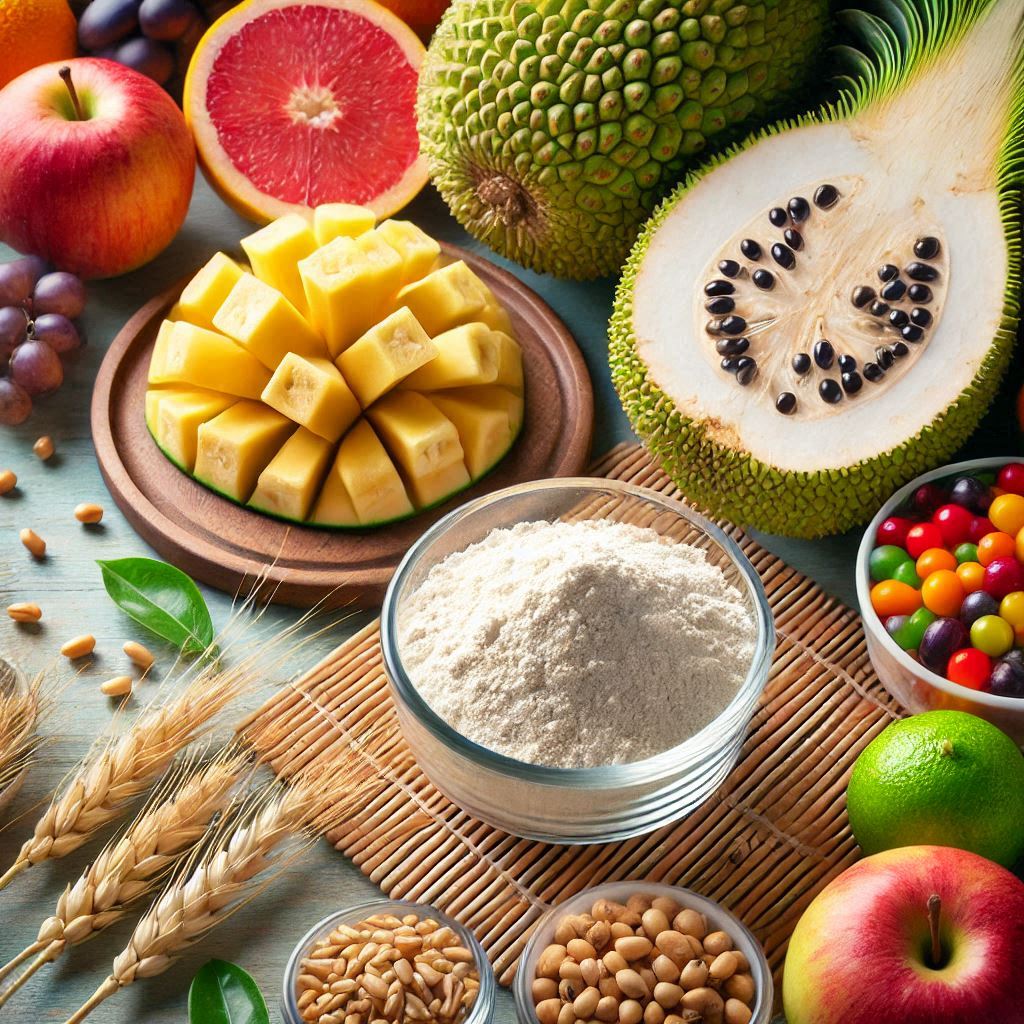
In recent years, the health and wellness trend has shifted towards exploring alternative flours, with many people seeking out gluten-free options or unique nutritional benefits. One intriguing alternative that has gained attention is jackfruit flour, made from dried jackfruit pulp. But how does it stack up against conventional wheat flour? Let’s dive into a nutritional comparison between jackfruit flour and wheat flour to help you make an informed choice for your dietary needs.
When it comes to baking and cooking, flour plays a crucial role in determining the texture, flavor, and nutritional value of your dishes. In recent years, jackfruit flour has gained popularity as a gluten-free alternative to traditional wheat flour. But how does it stack up nutritionally? Let’s dive into a head-to-head comparison of jackfruit flour and wheat flour.
1. Gluten Content
- Jackfruit Flour: One of the standout features of jackfruit flour is that it’s completely gluten-free. This makes it an excellent option for individuals with celiac disease or gluten sensitivity.
- Wheat Flour: In contrast, wheat flour contains gluten, a protein that helps give baked goods their elasticity and chewiness. While gluten is harmless for most people, those with sensitivities must avoid it.
2. Nutritional Density
- Jackfruit Flour: Jackfruit flour is rich in vitamins and minerals such as vitamin A, vitamin C, and potassium. It also contains dietary fiber, which promotes digestive health and satiety.
- Wheat Flour: Wheat flour is a good source of B vitamins, including niacin, thiamine, and riboflavin. However, it contains fewer micronutrients compared to jackfruit flour, especially when using refined white flour.
3. Fiber Content
- Jackfruit Flour: Jackfruit flour boasts a high fiber content, which can aid in digestion and promote gut health. It typically contains about 10 grams of fiber per 100 grams of flour.
- Wheat Flour: Whole wheat flour provides more fiber than all-purpose white flour, with around 12 grams per 100 grams. However, for those using refined flour, the fiber content is markedly lower due to the removal of the bran and germ.
4. Caloric Value
- Jackfruit Flour: Jackfruit flour tends to be lower in calories compared to wheat flour, making it a favorable choice for those looking to manage their weight while still enjoying baked goods.
- Wheat Flour: While not excessively high in calories, wheat flour averages around 364 calories per 100 grams. Those watching their caloric intake may find jackfruit flour a more appealing option.
5. Sugar Content
- Jackfruit Flour: Naturally, jackfruit flour contains a higher amount of sugars compared to wheat flour as it is derived from the fruit. However, these are natural sugars and come with beneficial nutrients and fiber.
- Wheat Flour: Wheat flour has a very low natural sugar content, but it can spike blood sugar levels quicker, especially if refined.
6. Taste and Texture
- Jackfruit Flour: Jackfruit flour has a slightly sweet and fruity flavor, which can enhance the taste of certain baked goods, making it ideal for dessert recipes.
- Wheat Flour: Wheat flour has a neutral taste, making it versatile for both sweet and savory applications. The texture tends to be denser compared to jackfruit flour, especially in gluten-free baking.
7. Cooking Applications
- Jackfruit Flour: Jackfruit flour works best in recipes that capitalize on its unique flavor, such as pancakes, muffins, or smoothies. It may require blending with other gluten-free flours for optimal results in yeast breads.
- Wheat Flour: Wheat flour is the classic choice for all kinds of baking, from breads and pastries to cookies and cakes. Its gluten content allows for a variety of textures and structures in baked products.
What are The Key Nutritional Differences between Jackfruit Flour and Wheat Flour?
Jackfruit flour and wheat flour differ significantly in their nutritional profiles, making them suitable for various dietary needs. Jackfruit flour is higher in dietary fiber, providing a more beneficial effect on digestion and promoting a feeling of fullness. It also boasts a lower glycemic index compared to wheat flour, making it a favorable option for those managing blood sugar levels. Furthermore, jackfruit flour is gluten-free, making it an excellent alternative for individuals with gluten sensitivities or celiac disease. Conversely, wheat flour is a rich source of protein and contains gluten, which contributes to its elasticity and ability to rise in baked goods. While both flours provide essential nutrients, jackfruit flour offers unique advantages for a diverse and health-conscious diet.
How does the Fiber Content of Jackfruit Flour Compare to That of Wheat Flour?
Jackfruit flour boasts a significantly higher fiber content compared to wheat flour, making it an excellent alternative for those seeking to increase their dietary fiber intake. While wheat flour typically contains around 2-3 grams of fiber per 100 grams, jackfruit flour can provide upwards of 10 grams of fiber due to its unique composition and the presence of bulk-forming fibers unearthing numerous health benefits. The consumption of jackfruit flour not only aids in digestion and promotes gut health but also helps regulate blood sugar levels and supports weight management by fostering a feeling of fullness. This makes jackfruit flour a desirable choice for health-conscious individuals and those looking for gluten-free options.
Are There any Specific Health Benefits Associated with Using Jackfruit Flour over Wheat Flour?
Jackfruit flour offers several health benefits that make it a valuable alternative to traditional wheat flour. Rich in dietary fiber, jackfruit flour aids in digestion and can help regulate blood sugar levels, making it an excellent choice for individuals with diabetes. Additionally, it is naturally gluten-free, which makes it suitable for those with celiac disease or gluten sensitivities. Jackfruit flour is also packed with essential nutrients, such as vitamins A and C, potassium, and phytonutrients, which support immune function and overall health. Furthermore, its high antioxidant content can help combat oxidative stress, contributing to better long-term health outcomes. Overall, incorporating jackfruit flour into the diet can provide a nutritious and versatile alternative to wheat flour.
How do The Protein Levels in Jackfruit Flour Differ from Those in Wheat Flour?
Jackfruit flour is increasingly recognized as a nutritious alternative to traditional wheat flour, particularly in terms of its protein content. While wheat flour typically contains around 10-15% protein, jackfruit flour boasts a relatively lower protein concentration, usually ranging from 1.5% to 2.5%. However, jackfruit flour presents a distinct advantage with its unique combination of nutrients, including fiber, vitamins, and minerals, making it an attractive choice for those seeking gluten-free options. This difference in protein levels highlights the diverse nutritional profiles of the two flours, emphasizing the importance of considering specific dietary needs and health benefits when choosing between jackfruit and wheat flour.
Can Jackfruit Flour be Used as a Substitute for Wheat Flour in Baking Recipes, and if so, How Does it Affect The Texture and Flavor?
Jackfruit flour can indeed be used as a substitute for wheat flour in baking recipes, offering a unique twist to various dishes. When incorporated into baked goods, it tends to impart a slightly sweet and fruity flavor, which can elevate the taste profile of items like pancakes, muffins, and bread. However, the texture of the final product may differ; jackfruit flour is gluten-free, which means it lacks the elasticity and structure provided by gluten in wheat flour. As a result, baked items may be denser and crumbly, requiring an adjustment in liquid ratios or the addition of binding agents like eggs or flaxseed to achieve the desired consistency. Using jackfruit flour can also enhance the nutritional value of baked goods, adding fiber and essential vitamins, making it a versatile and healthful alternative in the kitchen.






